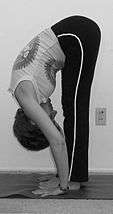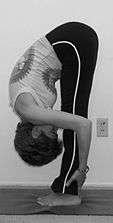Uttanasana


Uttanasana (OOH-tah-NAH-sah-nah)[1] (Sanskrit: उत्तानासन; IAST: uttānāsana), Intense Forward-Bending Pose,[2] Intense Stretch Pose,[3] Standing Forward Bend,[4][5][6][7][8][9][10] Standing Forward Fold Pose,[11][12] or Standing Head to Knees Pose[1] is an asana.
Etymology
The name comes from the Sanskrit words
Ud (उद्; ud) = prefix for verbs or nouns, indicating superiority in location, rank, power, intensity
Tana (तान; tāna) = "stretched"
Uttana (उत्तान; uttāna) = "intense stretch" or "straight" or "stretched",[13] and
Asana (आसन; āsana) meaning "posture" or "seat".[14]
Description
The asana consists of standing with feet together, then hinging forward from the hips, letting the head hang, with palms placed flat on the floor near the feet.
Murghasana - Advance version of Uttanasana
Yoga has an ancient history of ancient India. Most of the words are drived from Hindi Language. Murgha in Hindi means Cock/Hen. Murghasana is also called Hen Posture. In this variation the Yogi has to bend down, Pass arms between legs and hold her ear lobes with thumb and index fingers, in easy words, holding ears lobes while in uttanasana posture. This posture is very good for blood circulation on brain and face. It removes untimely wrinkles, sharps memory and brings glow to your face.
An average yogi can easily hold this posture up to 2-3 minutes but yogis with practice can increase their time up to 15minutes as well.
Anatomical focus
The asana provides a complete stretch to the entire back of the body, particularly the hamstrings.
Contraindications and cautions
This asana has been criticized by some practitioners of kinesiology, physical therapy, and others, who recommend a seated rather than standing forward bend.[15][16][17][18]
Alternative asana
Paschimottanasana is a safer, sitting variant of this frontbend which relies more upon active flexibility of the muscles in its later stages. It is more difficult to attain similar flexibility since gravity cannot passively aid the stretch as much as in Uttanasana. Once the hands are able to bear more and more weight in Uttanasana it becomes safer and the difference in safety and customizability becomes less. Although it could be argued that Paschimottasana is not a safe forward bend for the back as the pelvis can become locked and tight hamstrings add excessive pull on lower back via pelvic sit bones.
Variations
This asana has a very large number of variations and associated techniques.
- Ardha Uttanasana (Sanskrit: अर्धउत्तानासन; IAST: ardhauttānāsana)[19]
- Niralamba Uttanasana[20]
- Parsva Bhaga Uttanasana[20]
- Purna Uttanasana[20]
- Tiryang-Mukha Uttanasana[20]
Padahastasana

Padahastasana (/ˌpɑːrəˌhɑːstəˈɑːsənə/; Sanskrit: पादहस्तासन; Sanskrit pronunciation: [pɑːd̪ɐɦɐs̪t̪ɑːs̪ɐn̪ɐ]; IAST: pādahastāsana) or Hand Under Foot Pose is an asana.[21]
- Etymology
The name comes from the Sanskrit words pada (पाद; pāda) meaning "foot", hasta (हस्ता; hastā) meaning "hand", and asana (आसन; āsana) meaning "posture" or "seat".[14]
- Description
Padahastasana is a standing, inverted asana which the hands are stretched down to grasp the feet.
- Anatomical focus
The pose stretches the entire back of the body from the head to the heels.
See also
Further reading
- Iyengar, B. K. S. (1 October 2005). Illustrated Light On Yoga. HarperCollins. ISBN 978-81-7223-606-9. Retrieved 9 April 2011.
- Saraswati, Swami Janakananda (1 February 1992). Yoga, Tantra and Meditation in Daily Life. Weiser Books. ISBN 978-0-87728-768-1. Retrieved 11 April 2011.
- Saraswati, Swami Satyananda (1 August 2003). Asana Pranayama Mudra Bandha. Nesma Books India. ISBN 978-81-86336-14-4. Retrieved 9 April 2011.
- Saraswati, Swami Satyananda (January 2004). A Systematic Course in the Ancient Tantric Techniques of Yoga and Kriya. Nesma Books India. ISBN 978-81-85787-08-4. Retrieved 9 April 2011.
External links
- "Witold Fitz-Simon - Uttanasana". Retrieved 2011-04-11.
References
- 1 2 Budilovsky, Joan; Adamson, Eve (2000). The complete idiot's guide to yoga (2 ed.). Penguin. p. 208. ISBN 978-0-02-863970-3. Retrieved 11 April 2011.
- ↑ Long, Ray (22 January 2011). Yoga Mat Companion 1: Anatomy for Vinyasa Flow and Standing Poses. Greenleaf Book (Distributor). p. 64. ISBN 978-1-60743-943-1. Retrieved 11 April 2011.
- ↑ Active Interest Media, Inc. (March 1988). Yoga Journal. Active Interest Media, Inc. p. 30. ISSN 0191-0965. Retrieved 11 April 2011.
- ↑ "Yoga Journal - Standing Forward Bend". Retrieved 2011-04-11.
- ↑ Feuerstein, Georg; Payne, Larry (5 April 2010). Yoga For Dummies. For Dummies. p. 99. ISBN 978-0-470-50202-0. Retrieved 11 April 2011.
- ↑ Active Interest Media, Inc. (May 2006). Yoga Journal. Active Interest Media, Inc. p. 101. ISSN 0191-0965. Retrieved 11 April 2011.
- ↑ Beeken, Jenny (November 2003). Your Yoga Body Map for Vitality. Polair Publishing. p. 28. ISBN 978-0-9545389-1-0. Retrieved 11 April 2011.
- ↑ Mohan, Angarai Ganesha (29 October 2002). Yoga for body, breath, and mind: a guide for personal reintegration. Shambhala. p. 60. ISBN 978-1-57062-977-8. Retrieved 11 April 2011.
- ↑ Powers, Sarah; Grilley, Paul; Carden, Matthew (9 December 2008). Insight Yoga. Shambhala Publications. p. 127. ISBN 978-1-59030-598-0. Retrieved 11 April 2011.
- ↑ Jain, M. R. Science of Yoga & Health. Prof Dr Mohan Raj Jain. p. 57. GGKEY:54BDXW1KA4U. Retrieved 11 April 2011.
- ↑ Schiffmann, Erich (1 December 1996). Yoga: the spirit and practice of moving into stillness. Pocket Books. p. 168. ISBN 978-0-671-53480-6. Retrieved 11 April 2011.
- ↑ Hirschl, Meta Chaya (2010). Vital Yoga: A Sourcebook for Students and Teachers. Prajna Publishing. p. 145. ISBN 978-0-9823055-0-8. Retrieved 11 April 2011.
- ↑ "Uttanasana A - AshtangaYoga.info". Retrieved 2011-04-11.
- 1 2 Sinha, S.C. (1 June 1996). Dictionary of Philosophy. Anmol Publications PVT. LTD. p. 18. ISBN 978-81-7041-293-9. Retrieved 9 April 2011.
- ↑ Exercises that could be harmful | Better Health Channel
- ↑ Hawaii News, Honolulu, Honolulu News, Sports, Editorial, Features, Travel and Business - Honolulu Star-Advertiser - Hawaii Newspaper
- ↑ Exercise Is Medicine? How To Make It Healthy Medicine™
- ↑ Stretching
- ↑ Calhoun, Yael; Calhoun, Matthew R.; Hamory, Nicole (December 2008). Yoga for Kids to Teens. Sunstone Press. p. 167. ISBN 978-0-86534-686-4. Retrieved 5 July 2011.
- 1 2 3 4 Ramaswami, Srivatsa; Krishnamacharya, T. (3 June 2005). The complete book of vinyasa yoga: an authoritative presentation, based on 30 years of direct study under the legendary yoga teacher Krishnamacharya. Da Capo Press. p. 16. ISBN 978-1-56924-402-9. Retrieved 5 July 2011.
- ↑ "Witold Fitz-Simon - Padahastasana". Retrieved 2011-07-04.